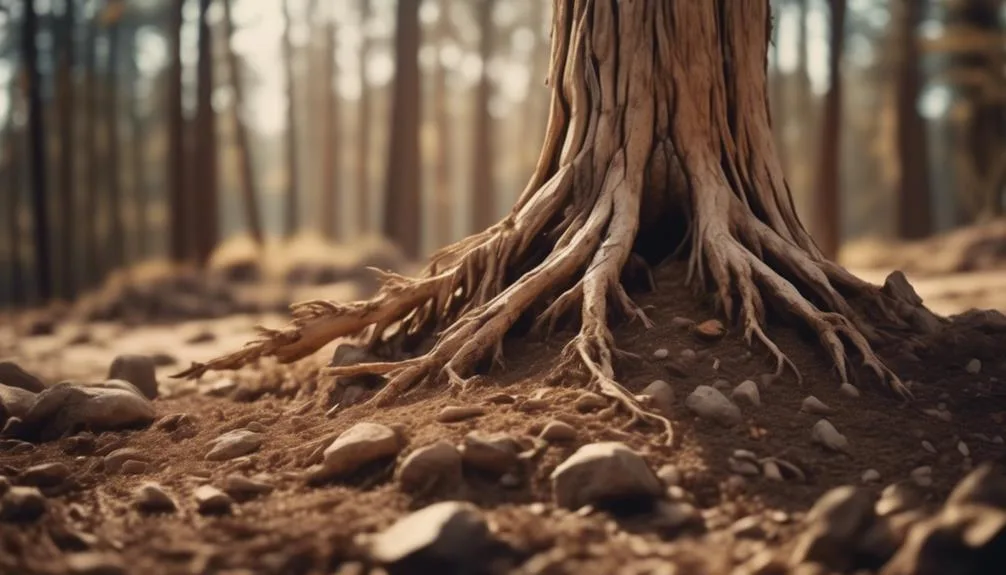Is your cedar tree growing slower than you expected? Even with good care, cedar trees can grow slowly due to various reasons. Understanding these factors can help you promote healthier growth for your tree.
Environmental factors, soil quality, and potential pests can all play a role. By understanding these causes, you can make informed decisions and take the necessary steps to help your cedar tree thrive.
Environmental Factors
When it comes to understanding the growth of cedar trees, environmental factors play a crucial role in shaping their development. Cedar trees thrive in various climate conditions, but they generally prefer areas with moderate temperatures and adequate moisture. Sunlight exposure is also vital for their growth, as it directly impacts their photosynthesis and overall health.
However, excessive air pollution can hinder their growth and cause damage to their foliage. Elevation effects should also be taken into account, as cedar trees at higher elevations may experience harsher weather conditions and reduced access to essential nutrients.
Understanding these environmental factors is essential for ensuring the optimal growth of cedar trees in your area. By providing suitable conditions, you can support the healthy and robust development of these majestic trees.
Soil Quality
To facilitate the healthy growth of cedar trees, it's essential to prioritize the quality of the soil in which they're planted. Nutrient deficiency and pH imbalance can significantly hinder your cedar tree's growth.
Cedar trees require specific nutrients to thrive, and if the soil lacks essential elements such as nitrogen, phosphorus, or potassium, it can stunt their development. Similarly, an incorrect pH balance in the soil can impede the tree's ability to absorb necessary nutrients.
Compacted soil and root restriction are additional factors that can hamper cedar tree growth. When soil is too compacted, it restricts the movement of water, air, and nutrients, while root restriction limits the tree's ability to establish a strong root system.
Ensuring optimal soil quality is crucial for promoting the healthy growth of your cedar trees.
Watering and Drainage
Ensuring optimal soil quality is crucial for promoting the healthy growth of your cedar trees. Proper watering and drainage are essential components that directly impact the overall health and development of your cedar trees.
Improper watering can lead to issues such as excessive moisture, which in turn can cause root rot, stunting the growth of your cedar trees. It's important to strike a balance with watering, as both under-watering and over-watering can be detrimental.
Overly compacted soil can also impede drainage, leading to waterlogging around the roots. This can suffocate the roots and create an environment conducive to root rot. Ensuring good drainage through measures like adding organic matter to the soil and avoiding soil compaction will help maintain the health and vitality of your cedar trees.
Pest and Disease Infestation
Pest and disease infestation poses a significant threat to the health and vigor of your cedar trees, requiring proactive management and careful observation to safeguard against potential damage.
Fungal infections like cedar apple rust and cedar-hawthorn rust can cause defoliation and weaken the tree. Insect infestations such as cedar bark beetles and spider mites can also lead to stunted growth and dieback.
To address these issues, consider using targeted pesticides specifically formulated for cedar tree pests. However, if you prefer a more natural approach, neem oil and horticultural oils can be effective remedies for controlling certain insects.
Regularly inspect your cedar trees for signs of disease and pest presence, and promptly address any issues to promote healthy growth and longevity for your beloved trees.
Pruning and Maintenance
Inspecting your cedar trees regularly for signs of disease and pest presence can also provide an opportunity to assess their pruning and maintenance needs to ensure healthy growth and longevity. Proper pruning and maintenance are crucial for maintaining the health and vitality of your cedar trees.
Here are some key aspects to consider:
- Branch Structure: Evaluate the overall structure of the branches, removing any dead, damaged, or crossing branches to promote better air circulation and light penetration.
- Growth Patterns: Observe the growth patterns of the cedar tree and prune accordingly to encourage balanced growth and prevent overcrowding.
- Clearing Debris: Regularly remove any debris or dead wood from the tree to prevent disease and pest infestation.
- Professional Assessment: Consider seeking professional arborist services for a comprehensive assessment and specialized care.
Conclusion
To ensure your cedar tree's optimal growth, it's essential to address environmental factors, soil quality, watering, drainage, and potential pest and disease infestations.
Regular pruning and maintenance play a crucial role in promoting healthy growth.
By staying attentive to these aspects and making necessary adjustments, you can help your cedar tree thrive and flourish.
Mark Hoffman is a dedicated arborist and tree care specialist with over a decade of experience. His love for trees began when he visited Yosemite National Park as a teenager and was awestruck by the giant sequoias. Mark pursued his passion by studying forestry at Michigan Technological University, where he earned a Bachelor of Science degree.
Since then, he has worked tirelessly in the field of arboriculture, helping to preserve and protect trees in his community. His expertise and dedication have made him a respected leader in the industry and a valuable resource for anyone seeking advice on tree care.
